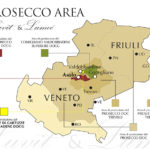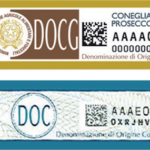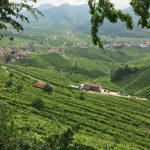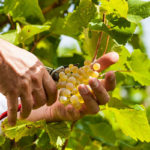-
Prosecco Valdobbiadene D.O.C.G.
-
-
Prosecco Valdobbiadene D.O.C.G.
Prosecco Superiore BRUT, Valdobbiadene D.O.C.G.
-
Prosecco Valdobbiadene D.O.C.G.
Prosecco Superiore EXTRA-DRY, Valdobbiadene D.O.C.G.
-
-
Prosecco D.O.C. Treviso
Prosecco Brut, D.O.C. Treviso
-
Prosecco D.O.C. Treviso
Prosecco Extra-Dry D.O.C. Treviso
-
Prosecco D.O.C.
Prosecco Extra-Dry “Casot de Tecia”, D.O.C.
-
Frizzante
Vino Bianco Frizzante “Tappo Corona”
-
Prosecco D.O.C.
Prosecco Dry “Casot de Tecia”, D.O.C.
-
Prosecco D.O.C. Treviso
Prosecco Frizzante Legatura Spago, D.O.C. Treviso
-
Prosecco D.O.C. Treviso
Prosecco Tranquillo, D.O.C. Treviso
-
Rosè
Rosè di Pinot, Brut
-
-
-
-
Vino Rosso
Cabernet Veneto I.G.T. “Campo Croce”
-
D.O.C. Colli Euganei
Moscato “Girasole”, D.O.C. Colli Euganei
-
Grappa
Grappa di Prosecco “Montegrappa”
The grapes used for producing Prosecco come from Glera vines, initially called Prosecco. Its loosely packed white grapes, with long and fine peduncle and delicate berries are golden yellow. The vine shoots are nut brown. Sprouts are vertically oriented. During vegetation cycles topping and pruning operations are carried out. In this way it is possible to check the quantitative production as well as help the development of aromatic qualities, which will then enrich the aroma of the wine.
Rules prescribe that spacing is at least 2.300 vines per hectare; they allow that other native vines such as Verdiso, Perera or Bianchetta are planted in the vineyard in a percentage lower than 15%. Cultivation techniques are the classical ones: double Gouyot is typically used, whereas pergola (arbours) is not admitted.
Prosecco is a D.O.C. wine so producing areas are strictly limited to places where just the ideal environmental conditions are to be met.
The following provinces are authorized to produce Prosecco: Treviso, Venezia, Belluno, Vicenza, Padova (Veneto region), which represent 80% of the total production. Furthermore, the 4 provinces of Trieste, Pordenone, Gorizia and Udine (Friuli Venezia Giulia region) are included and cover the 20% of the total production.
Vines growing in different areas of this large territory may be producing wines with different aromatic shades. The climate in this territory, though, is generally mild: on the northern side the Alps protect the area from cold Nordic winds, the hills are warmed by the winds blowing from the Adriatic Sea, which bring useful rain to develop vines and mild temperature. Sharp shifts in temperatures from day to night are typical of the end of summer: they help the development of aromatic shades while grapes are ripening. The soil has alluvial origins: it’s typically muddy, rich in clay, mineral sediments and micro-elements. All this makes the perfect environment for fine spumante grapes.
In the 90s Prosecco started becoming more and more popular. By then it was known as Prosecco IGT (Indicazione Geografica Tipica). Afterwards, on July 17th, 2009, it received the DOC (Denominazione di Origine Controllata) designation and its production started being ruled by stricter regulations which prescribe a limit to 1800 kg per hectare and set a precise list of authorized areas of cultivation.
Furthermore, when the processes of harvesting, wine-making and bottling are carried out in the Province of Treviso or Trieste, it is also possible to label a Prosecco DOC with a TREVISO or TRIESTE designation.
SUPERIORE DI CARTIZZE VALDOBBIADENE D.O.C.G., PROSECCO SUPERIORE CONEGLIANO-VALDOBBIADENE D.O.C.G. and ASOLO PROSECCO SUPERIORE D.O.C.G. are the 3 wine-making districts of Treviso and Trieste’s geographical areas.
Let’s find out more about these three micro-areas that produce the best Prosecco wine ever.
Cartizze is a refined spumante wine. It is produced with Glera 100% grapes cultivated in a limited area of 107 hectares in the heart of Valdobbiadene. Grape yards extend over a sunny territory from the towns San Pietro di Barbozza, Saccol, Fol to Santo Stefano. The soil composition is rich in sandstones, limestones and clay. These elements contribute to make this territory a unique location where grapes ripen and develop the most refined aromas. The Prosecco produced here has a strong and fine perlage, its taste is delicate, floral and fruity.
Where does the name Cartizze come from? In the past grapes were harvested late, when berries were about to dry. Afterwards, they were wrapped into corn husks (called “cartize”) in order to raise the sugar rate of grapes. When harvested, grapes were laid onto some gratings (called “gardiz” or “gardizze” in the local dialect) in order to let them dry. When the process of drying was over, wine-making processes were started and a sweet wine was produced. Over the years the sugar rate has been lowered. Nowadays Cartizze is an excellent DRY wine, the perfect choice for a dessert.
Prosecco Superiore was created in 2010. This spumante is produced on the hills from Conegliano and Valdobbiadene, more precisely in Conegliano, Susegana, San Vendemiano, Colle Umberto, Vittorio Veneto, Tarzo, Cison di Valmarino, Follina, Miane, San Pietro di Feletto, Refrontolo, Pieve di Soligo, Farra di Soligo, Vidor and Valdobbiadene. The limit of yield per hectare in this area is 1350 kgs. Producing processes are strictly checked by government agencies. When labels show the RIVE designation, it means that this wine has been produced with hand harvested grapes original from the 43 hills. If a wine is designed as a RIVE wine, yield per hectare is even lower: 1300kgs per hectare. The Conegliano Valdobbiadene wine has a straw yellow colour, delicate and fruity aroma and is an elegant and fine wine. It can be matched to appetizers or desserts.
Cultivation area of Asolo Prosecco, as stated in 2014 rules , can be carried out in the towns of Castelcucco, Cornuda and Monfumo and in some parts of the towns Asolo, Borso del Grappa, Caerano S. Marco, Cavaso del Tomba, Crespano del Grappa, Crocetta del Montello, Fonte, Giavera del Montello, Maser, Montebelluna, Nervesa della Battaglia, Paderno del Grappa, Pederobba, Possagno, S. Zenone degli Ezzelini and Volpago del Montello. Yield per hectare is limited to 1350kgs. This area spreads from Treviso north-west, Mount Grappa’s foot up to Asolo’s hills (one of Italy’s most beautiful “borghi”).
This refined Spumante has a delicate straw yellow colour, fine and persistent perlage and fruity aroma. The taste is structured and fruity. This wine can be matched to any dish, from appetizers to desserts.
On July 9th, 1876 King Vittorio Emanuele signed a decree and authorized the first Scuola di Vinicoltura e di Enologia (Wine-making and Oenology School) to be opened. The headquarters of the school were opened on September 24th, 1924 and since then Mr. Antonio Carpenè started improving the Charmat or Martinotti method. Glera grapes are harvested and later softly pressed, in order to extract the “mosto fiore” (the most refined and important juice). The soft wort is left in stainless steel barrels to decant for 10/12 hours at a temperature of 5/8°C. After this process the wort is filtered and mixed to enzymes that start the alcoholic fermentation. It lasts for 15/20 days at a temperature of 18/20°C. At the end of this wine-making process the result is a basic wine, which has to be filtered and purified. This basic wine is then mixed to other kinds of basic wines, in order to obtain different wine combinations. The couvèe process is carried out in stainless steel autoclaves, where yeast and sugar are added to the liquid. This process will last at least 30 days, when the wine will be ready to be sold.
SPUMANTE: prosecco pressure 4,5 bar 20°c., min. 11,00% vol.
SPARKLING: sparkling prosecco: max. pressure 2,55 bar 20°c., min. 9% vol.
STILL: Prosecco liscio, called “still”: min. pressure 0,5 bar 20°c., min. 10,50% vol.
| Denomination | Sugar residual (g/L) |
| Pas dosé or 0 dosage | < 3 |
| Extra Brut | ≤ 6 |
| Brut | < 12 |
| Extra dry | 12-17 |
| Dry or Sec | 17-32 |
| Demi sec | 32-50 |
| Dolce or Doux | >50 |
| Size | Liters |
| Mini | 0,187 / 0,200 Liters |
| Demi | 0,375 Liters |
| Classic | 0,75 Liters |
| Magnum | 1,5 Liters |
| Geroboam | 3 Litri |
| Mathusalem | 6 Litri |
| Salmanazar | 9 Litri |




